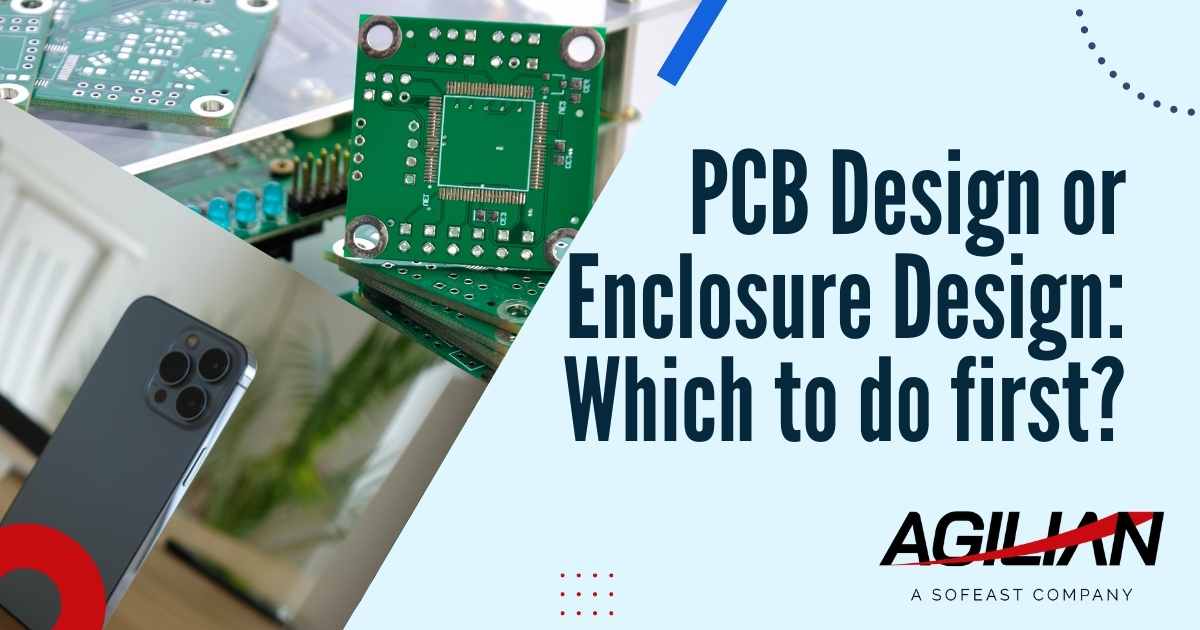
Should you do PCB design or enclosure design first for your new electro-mechanical product? That’s a question which bugs many entrepreneurs and SMEs who’re designing and developing their new product idea, and we’ll get to the bottom of it here.
If you prefer you can listen to this post here:
What comes first? PCB or enclosure design?
So, enclosure or PCB design which one should it be first? It’s quite a chicken and egg situation and is really difficult to decide without knowing much about the product. The design of both boils down to what makes sense for that product not only in the design team’s office but also with the customers you’re going to sell this product to.
If customers demand a smaller package then the enclosure may be the design to focus on first, however, if you need to build a product that really functions well then you might design the PCB first thing and try and design the enclosure based on its dimensions and requirements. For example, iPhone customers wouldn’t tolerate a phone that is as large as a laptop, so in that case, the enclosure size is a crucial benchmark to work to.
If a design engineer habitually always does the PCB design first they may run into some problems when they try to place it into an enclosure that just isn’t the right size or shape once it has been designed for the product, and vice versa.
Either of these scenarios could happen, and both might require design changes to either the PCB or enclosure in order for them to work together for the product. Changes necessarily cost more time and money, two things that you need to save, and issues like this will often stem from a lack of communication between the cross-functional teams working on the new product.
A 5-step process to help you make the right design decisions for your project
Make sure that you have the following 5 items identified and discussed within teams as they will help make your design decisions easier:
1. Create a proper PRD
Create a product requirement document or PRD. This typically comes from the product engineering team and they design the form, fit, and function of the early and concept product. They’ll also create the product user manual and clarify specific product requirements, such as if it needs to be able to withstand a certain drop height. The PRD will help the design team to have a good idea of what the product design should include.
2. Do Industrial Design
ID for the product is crucial to its success and is as creative as when a fashion designer works on new clothing designs to make them sophisticated, yet formal at the same time. The ID will help the designers understand how the product looks and feels in detail and should also have a detailed or at least rough estimate of the product’s dimensions (length width, height, and so on). This, clearly, will help the designer to understand what dimensions the PCB has to fit into, where the buttons and LCD should be, and so on.
3. Clarify product functionality
Devising and writing down the product functionality gives important technical information about the product such as its max operating temperature, max operating voltage and current, and how it needs to operate. For example, if the product is a telephone, the functionality will outline what kind of LCD is to be used, the features required, and all the features, functionality, parameters, and maybe most of the detailed electrical specifications in terms of how they should be designed.
4. Create a detailed BOM
Your Bill Of Materials gives the picture of what kind of components and materials need to be used, how they need to be sourced, how many of each are in the product, and whether or not the initial cost estimate (at least) is within the ballpark of the project funding. Designers need to be aware of the BOM as its contents may influence their decisions.
5. Perform competitive analysis and market research
When you’re designing a brand new product there may be only one or two similar competitors out there, so obtain samples of these products for competitive analysis or maybe even re-engineering so that you can design your product 10x better in terms of functionality or design or features.
You also need to get feedback from customers in order to understand their requirements. For example, they may value a smaller, larger, extra-durable, or even cheaper version of the product, so your design team need to know this so they don’t go ahead and, say, design a product that is too lightweight even though the customers demand something more durable for industrial use.
Next, discuss all of the above points in a cross-functional team meeting
A cross-functional team including heads of departments from design, development, reliability, purchasing, manufacturing, etc, should meet and discuss all of this information that you now have when deciding where to start with the new product design.
Based on the product aesthetics, requirements, features, etc, in hand, after some brainstorming, it should become a lot clearer whether they need to tackle PCB or enclosure design first.
How about your project? Are you stuck and in need of some support to design, develop, and manufacture your product concept? Let us know, our designers and engineers are here to help.



